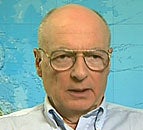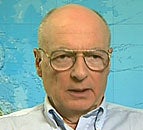 Kenneth A. Rahn, a University of Rhode Island atmospheric chemist has analyzed air pollution data collected regularly for the last five years by Chinese scientists.
Kenneth A. Rahn, a University of Rhode Island atmospheric chemist has analyzed air pollution data collected regularly for the last five years by Chinese scientists.
It is August 7, 2008, one day before the opening ceremonies of the Summer Olympics in Beijing. The sweeping ban on cars, factories, construction, etc., instituted on July 20 seems to have had no detectable effect on air pollution in Beijing. Days after the ban, the air pollution even doubled. After three days of blue skies in the first days of August, air pollution has returned to Beijing with a vengeance. The visibility is now so bad that only part of the famous Bird’s Nest can be seen from 100 meters away. Yesterday, buildings were disappearing from view by the hour.
We are witnessing one of Beijing’s normal summer episodes, caused by winds from the south bringing massive amounts of pollutants into the area. Beijing is only a minor player here—contributing maybe 30 percent during the worst conditions. The haze is regional, on the scale of hundreds of miles (maybe up to 1000 km or so). Sources in provinces well to the south are responsible for most of it.
It is entirely possible that the opening ceremony on Friday evening will be enshrouded by haze—a nightmare scenario for Beijing and the International Olympic Committee that selected them for this Olympics.
Since the Olympics stand for sportsmanship and truth, it is essential to be clear about what is happening here—that it is an episode of regional pollution just like many others that have come to northern China in the past and will continue to come in the foreseeable future. I was surprised to learn that people like Jacques Rogge, president of the International Olympic Committee, and Arne Ljungqvist, chairman of its medical commission, said that the smog is only natural fog or mist caused by “evaporation.” This is demonstrably false. When relative humidities are 60 percent to 70 percent, as they are on typical Beijing summer afternoons, the haze is pure particulate matter (pollution), and has nothing to do with fog or mist.
The larger question here may be the most troublesome. Although I don’t know the intention of the IOC, the result sounds like an attempt to cover up for China, whether deliberately or not. The Chinese people can speak for themselves on this matter. From my experience with the Chinese, they understand the reality of the pollution. I think although they will not be pleased with all the pollution, they would not deny that it is actual air pollution. The IOC is doing them a disservice by pretending otherwise. The IOC should stick with what they know—athletics—and leave air quality to scientists. (These comments are the author’s own, and do not necessarily represent those of the University of Rhode Island or Tsinghua University.)
Kenneth A. Rahn
University of Rhode Island
Tsinghua University
Friend of China
krahn@uri.edu
For more information about air quality measurements, go to http://karws.gso.uri.edu/APIppt.html.
Read earlier news from Dr. Rahn: Global News: URI Researcher says China can’t fix air quality for Olympics
For more information, contact the URI Department of Communications and Marketing, 401-874-2116.

